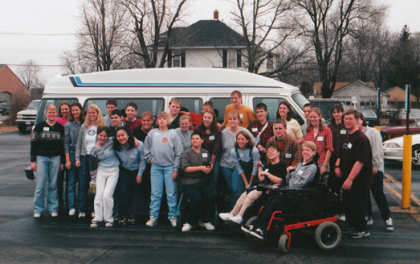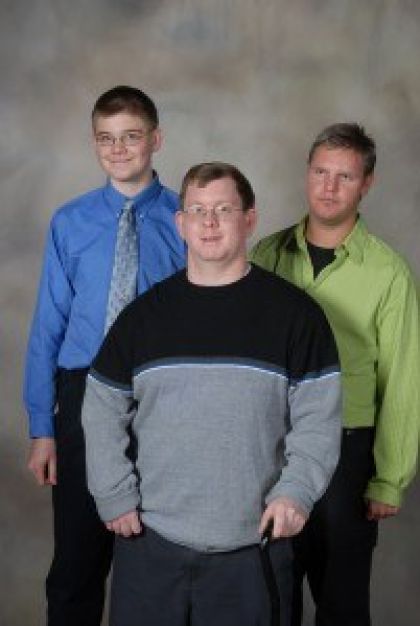Creating Connections: the Beginnings
The following is an excerpt from our eBook, “Creating Connections: Social Inclusion for High Schools” by Ellie Van Keulen. This eBook contains resources, encouragement, and the story of South Christian’s social inclusion program.

Early Connections participants gathered for an outing!
When South Christian High School (Grand Rapids, MI) opened up its doors to inclusive education in 1994, the Educational Support Services (ESS) staff had no idea how the first three students with disabilities would be accepted by colleagues and peers in the school community. Most teachers and students welcomed inclusion but with some fear and skepticism. Fear faded, however, as the students became part of the school fabric. Yet within a few years, ESS teachers and parents realized that full inclusion meant much more than merely accepting or tolerating someone with a disability within the school setting.
Full inclusion meant engaging the whole student: academically, socially, spiritually, and emotionally.
In the early days at South Christian, we found that our students were separated from many of the social aspects of high school and thus felt isolated within the school setting. They were part of the fabric, but not woven into the cloth.

Hennie's personality, love, joy, and faith taught the entire South Christian community
Though included in different classes during parts of the day, students with disabilities rarely mingled with other students outside of class. Even though students and teachers were friendly, most of the students with special needs would eat and interact in the inclusion room at break and lunch, but not with other South Christian students. At this point, we realized that the students with disabilities shared a common dream with their peers: desiring friends who would say “Hi” in the school halls and spend time with them outside of school. The challenge we faced was two-fold:
- the student body really had very few opportunities to interact with the students in the inclusion program, and
- many of the students with disabilities struggled with social skills.
It began weighing on our hearts that simply having students with disabilities within our building was not true inclusion. It had to be more than that; we needed to offer more than surface-level interactions.
Like many initiatives, change occurs through the participants. The students who we meant to educate, educated us! On the first day of school in 1995, the front doors of South Christian opened and in walked a young lady named Hennie. Her balance, walking gait, and speech had been affected by cerebral palsy. The ESS staff wondered and worried how staff and students would accept her. But, instead, Hennie educated all of us. Her bright personality, unconditional love for others, joy for life, and trusting faith were an example to the whole school.

Through his positive attitude and longing for friends, Tim Litton (center) helped set the foundation for the Connections program.
The following year, freshman Tim Litton entered our school. His positive attitude and longing for friends helped create another bridge. Tim, impacted by cerebral palsy and a significant hearing impairment, desired friends who, according to him, would not see him as “disabled, just as differently-abled.” Amazingly, this wish was fulfilled through three peers who stepped up to provide the gift of friendship. To this day, Tim identifies them as the “BAH” group: Ben, Adam, and Hess. Their friendships have lasted for the past 20 years.
Hennie and Tim taught us to realize that, in spite of including them in a number of general education classes throughout the day, there was an element of separation. For a great part of the day, Hennie and Tim felt separate, even though some students like the “BAH” group strove to bridge the gap. Just as our country realized long ago that “separate does not mean equal,” so too did Tim and Hennie push us further — to the beginning of the Connections program. Altogether, we felt that a focus on social inclusion was vital to true inclusion.
Next week, we’ll share how Connections has grown and changed over the years to include more than 200 students at South Christian.
Ellie Van Keulen
Ellie Van Keulen was an Educational Support Services (ESS) teacher at South Christian High School (Grand Rapids, MI) from 1994 until she retired in 2016. Ellie helped pioneer the educational and social inclusion program, which has grown to include more than half of the student body. She received her teaching degree from Calvin College and Grand Valley State University, with endorsements in Cognitive Impairment and Emotional Impairment. Ellie is married to Rob and has four children and two granddaughters.
